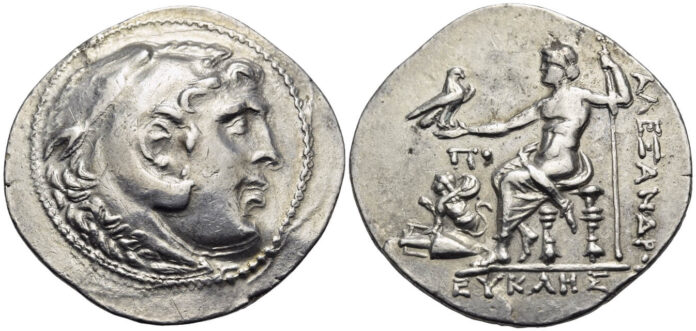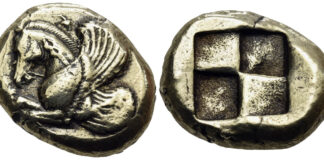Obolos 16: Vineyard Collection Part III
Well, there has been so much going on in the world these days that some people might make the mistake of thinking that, compared with covid-19 and presidential debates (among other things), coins were not of real importance. As we all should know, that would be very, very wrong!!! When you see and listen to politicians acting like tantrum-throwing children who desperately need their Mother to give them a spanking, looking at coins, with all their history, their iconography and their romance, are a very welcome diversion. When you think that these little discs of metal not only tell us so much, but have lasted 2000 years and more, well, it brings us all down to earth and calms us down. If you get tired of reading the newspapers about contemporary events, you can always take one of your coins and find out about the city that issued it, or the ruler who decreed that it be made. You can read one of those old-fashioned, well-written and, often exciting, references that are still highly accurate even if written 50 or 100 years ago; or you can read something written in a truly modern, dry, scholarly way, which will also be accurate, but will put you to sleep!
So now I am going to present some coins from Obolos 16 that seem intriguing. But first, a correction.
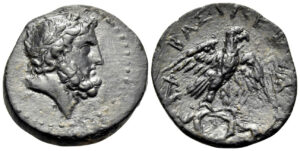
This is lot 940 (SP 150 CHF), which is identified in our catalogue, following the addenda of Volume II of SC (Ad 204), as a coin of the relatively short-lived Seleucid usurper Achaios. This is because it was given the manifestly imaginary inscription reading ΑΧΑΙΟΥ on the reverse (in fact, what is there is a monogram reading ΤΑΡ). So, in fact, it is a coin of Tarkondimotos, king of Cilicia (39-31 BC)! He is, of course, best known for his bronzes that bear his superb portrait on the obverse accompanied by a figure of Zeus on the reverse. This incorrect identification, derived from SC, has been followed by a number of auctioneers, all of whom apparently were able to see inscriptions that do not exist (too many drinks, hic, hic?)! Quite a skill! A kind of numismatic version of “fake news”. In any case, thanks to information from John Lavender (who was, in turn, informed by two erudite collectors) we now know that the correct identification was apparently made by the American scholar-dealer, Frank Kovacs some years ago. Nevertheless, this fact does not take away from the attractiveness of this coin; more to the point, the future buyer can contact Frank to receive a fascinating note about it!
The Vineyard Collection
You should know that the first part of Obolos 16 contains coins from the well-known Vineyard Collection (lots 1-526, Dionysopolis in Moesia to the island of Andros), which contains coins that have references to wine on them. We have coins with Dionysos, the god of wine, and all his acolytes, we have the vessels in which wine was stored and served; we have grapes and the vines on which they grow; we have wreaths worn during banquets; and we have coins minted by wine producing cities. These references can be substantive types or simply symbols – like those on staters of Corinthian type from northwestern Greece and Corinth. The owner was a passionate collector who wanted to have everything he could find from his area: he was not interested in perfect condition, but he wanted good, clear coins with a story to tell. He also very carefully bought from recognised auctions and dealers and sought out good provenances and pedigrees. Here are a few pieces that have caught my eye…
Lot 180 (SP 200 CHF) is a wine-related coin because of its symbol: an Alexander-Tetradrachm, struck at Kyme in Aeolis under a magistrate named Diogenes in c. 188-170 BC. It bears two symbols, the city-badge (the forepart of a horse on what seems to be a round shield) and a tall vessel, which seems to be a cross between a ladle-like drinking vessel – a kyathos – or a footed-rhyton. This was another symbol of the city and its wine industry.
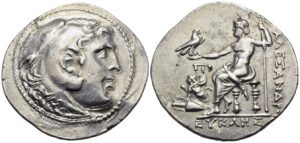
Here’s another Alexander from a wine-producing area, Chios (lot 187, SP 150 CHF). Struck c. 190-165 under a magistrate named Eukles, the symbol on this coin shows us the sphinx, Chios’s protective creature, perched on one the pointed Chian wine-transport amphorae that carried Chian wine all around the Mediterranean.
Coins from the town of Rhizos in Thessaly are all fairly uncommon, but this piece, (lot 208, SP 300 CHF) is quite special. It is a bronze trichalkon minted c. 352-344 BC, and it is of really fine style. The obverse shows us a noble head of Zeus, very similar on tetradrachms of Philip II, and the reverse a finely made bunch of grapes hanging from a branch. It also has a very fine pedigree: From the Vineyard Collection and those of C. Morcom and M. P. Vlasto!
A coin struck in Ambrakia in Epirus carries a pair of fascinating symbols. It is a Corinthian-type stater, minted probably to support Timoleon’s expedition to Sicily in the late 340s (lot 220, SP 150 CHF): not only do we have a two-handled kylix from which to drink wine, but even a bunch of grapes! The kylix was the most famous of Greek drinking vessels: as the party got drunker, and drunker they would play the game kottabos with it. That involved holding it by one handle, whirling it around, and then tossing the dregs out from it at a target on a high stand: if they hit it just right the target would fall off and then everyone would have another drink! This game had a habit of resulting in lots of broken kylices!!
The Athenians produced an immense amount of coinage, partially as a way of utilising their silver mines at Sounion. There are a considerable number of varieties, of which their tetradrachms must be the most familiar of all Greek coins. This pentobol or Ptolemaic drachm (lot 308, SP 400 CHF) is, however, one of the real rarities. It was struck c. 268-262 BC to help pay Ptolemaic troops who were allies in Athens’ loosing struggle with Macedon during the Chremonidean War. The coin was specially designed to be able to circulate as an Attic standard pentobol and a Ptolemaic standard drachm so that the troops could buy supplies in the local markets. There is an amphora on this coin, but its lid makes it clear that it is a Panathenaic Amphora, which was designed to contain olive oil given as a prize during the Panathenaic Games (not wine).
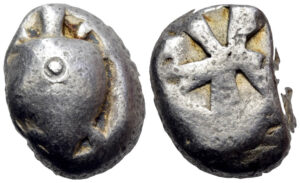
This is a coin that does not look like much (a Stater of Aegina, struck c. 535-475 BC, lot 330, SP 200)! In fact, as the original coin it is not much at all, but it has a great countermark. If you look at it properly, you will see an open vessel with a broad top and a somewhat narrower base. This is a wine serving and mixing vessel: a krater. It seems to be without handles but it should have had them; no doubt the punch-engraver probably found them too fiddly to include.
Now for a stater from Corinth with another vessel used for the wine ceremony: the hydria (lot 334, SP 125). The hydria was designed to carry the water that would be used to dilute the wine that had been poured into the krater (the Greeks thought that drinking uncut wine was the sign of a barbarian! Different percentages of water to wine were described in ancient sources, with the most wine being considered totally outrageous! The hydria had three handles, an upright one behind the lip (for pouring) and two horizontal ones on the sides (for lifting). Hydriai were quite fat-bodied, as here, though the side handles cannot be seen on this example since they were too difficult to engrave (Nike sits on a very similar hydria at Terina). This is why, in our description, our erudite cataloguer mistakenly termed it an oenochoe, a wine pitcher, but as can be seen in coins from Macedonian Terone (lot 158, SP 100 CHF), oenochoae were slim and tall, not fat!
Reverses of three bronzes from Andros, all dated to the 3rd-1st centuries BC (lot 365, 366 and 368, SPs 100, 100 and 75), show how much Andros was proud of its wine production. An amphora, with its handles going from the shoulder to the neck; a high-handled kantharos (a drinking cup); and one, with its round body, very thin neck, and handles going up from the body to the lip, a kind of amphora (NOT a kantharos) known as a loutrophoros, which was used for carrying water!

There many interesting Roman Provincial issues in the Vineyard Collection; many with figures of Dionysos of course. This one is special: lot 484 (SP 100 CHF) shows the infant Dionysos sitting in a wicker cradle holding out his hands to right (already asking for a drink?) with his thyrsos behind him!
You can find all lots at biddr, NumisBids and Sixbid. The Webauction will be live exclusively on the Nomos website.



